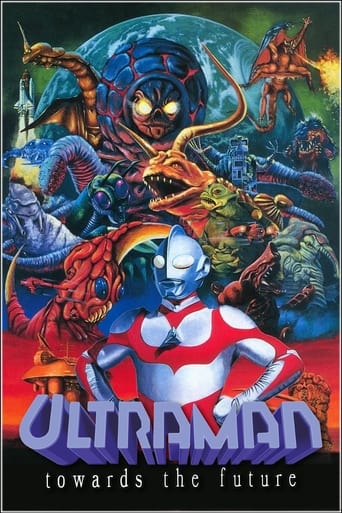xamtaro
Ultraman Toward the Future is not the first Ultraman TV series i watched. Ultraman Ace, taro, 80 and Leo were all shown in television before, but it was only Ultraman Toward the future, the second English language Ultraman Production, that made me become a fan of the Ultraman Franchise and actively seek out those Ultraman series that were never broadcast in my country. THe story starts of very mysteriously and the 2 plot arcs unfolds across 6 episodes per arc over 12 episodes only in total. In the first story arc, Jack Shindo and Stanely Haggard are members of the first manned expedition to Mars where they encounter a giant slug-like monster, Gudis. They are rescued by the mysterious silver and red giant ULTRAMAN but not before Gudis escapes to earth in the form of an alien virus and Stanley is presumably killed. To ensure Jack Shindo does not die on Mars, Ultraman joins with Jack, allowing Jack to summon the heroic giant whenever all hope seems lost. On earth He joins the UMA organization in order to help them battle the monsters created by the Gudis virus. THe story is very well plotted and does not drag. There is a fair amount of human drama and a little comic relief thrown in but does not detract from the overall dark feel of the story. Every character is fully fleshed out and immediately likable. One can develop an emotional connection with each of the characters, From the hot headed Jean Echo to the "straight to business" base commander Arthur Grant. The actors mostly Australian but of mixed heritage lending to a very diverse look for the main cast. Ultraman is not longer just a plot device to defeat the monster but a character onto himself who converses with Jack and helps him to deal with more subtle problems. Each episode deals not only with a monster but with very down to earth themes that anyone can relate to. Themes like the value of friendship and the importance of trust are interspersed with more theological themes of Purpose(reflected in how Jack finally defeated Gudis by brining to light the fallacy of its purpose, which is to destroy all life, and how it would no longer have a reason to exist when all life really is destroyed) and environmental themes(which are more prevalent in the 2nd half of the series). The plot, underlying themes and character interplay are just as interesting as any of the monster battles.Which BTW, the monster battles are years ahead of its time. The monsters are not just men in suits like the Japanese series but a mix of man in a suit, puppetry and props. Close-ups make use of still props of, for example, the monster's head or foot, which allows a greater level of detail. Puppetry is used to give the monsters a more organic feel, to give life to tentacles, antenna and wings instead of just letting them flop to the side like in the Japanese series. The special effects used for the powers are astounding. They look better than Power Rangers which came out 3 years after this show and just as good as Ultraman Tiga, which came out 6 years after this. The fight choreography doesn't make use of quick cuts, but rather, the director(Andrew Prowse, who would go on to direct a number of episodes of "Farscape") uses long panning shots from the ground level upward to give a grander feel and a sense of scale to the giant monster battles. Close ups are only used when necessary for dramatic effect. The design of Ultraman in this show is one of my favorites. Keeps true to the spirit of the original without any added gimmicks while creating a great looking character. This Ultraman is visibly bulkier and more muscular than the previous ones, looking more like a comic book hero than ever before. The miniatures are very intricately and realistically built and it helps that shots of miniatures are inter cut with shots of real cities. The Hummer flying scenes can look a little weird at times though due to the use of green screen against a still hanging model instead of real time puppetry. Ultraman Toward the Future is a great series for all ages. Unlike power Rangers, this show has an intelligent story with themes both simple and complex for children and adults; It even teaches good morals. The action is well paced and special effects are revolutionary for its time. A pity it only ran for 12 episodes. A great jumping on point for anyone looking to get into the Ultraman fandom.
Zillamen
Ultraman TTF is most likey one of the greatest mini-series about a superhero ever made. It offers monsters, action, humor, amazing special effects and very WELL DEVELOPED SCRIPTS (lacking from some other Ultra series). Jack Shindo is a great character, too bad the actor playing him hasn't done more films. The first half deals with the monster/poison named Gudis (edited for a feature direct to video). Even if the plot can become a little slow...the special effects can more than make up for it. The second half deals with...RANDOM CREATURES! Free of Gudis (personally, I don't get this. I mean, the natural monsters/mutations stop comming to let Gudis go ahead and destroy, wait for Ultraman to slay it, then go back to attacking). Despite the flaw, the writer does a good job here. My last nitpick is the fact that the character of Charles Morgan got VERY IRRITATING in some points and the fact that the Kudara costume looked awful on screen. Standing still it was realistic, but while fighting/rampaging, VERY OBVIOUS FOLDS CAN BE SEEN! Ultraman himself was well staged, had everything that a superhero needed to be (better than Superman!). Tall, (if 330ft counts) muscular, (no Bruce Lee, but passable) fires many beam weapons, knows very comic- bookesque poses, fight sceens are very realistic (makes the 90's Gamera look bad) and has a bit of humor in him. JACK: (upon being defeated by Kudara, and discovering another creature is on he loose) So we're in trouble. ULTRAMAN: You got it! JACK: What can we do? ULTRMAN: I'm open to suggestions. Truly a spectical for people of all ages. A must see! 10/10




